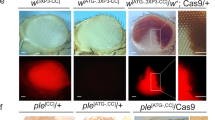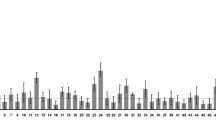Abstract
Duplicated genes and repetitive sequences are distributed throughout the genomes of complex organisms. The homology between related sequences can promote nonallelic (ectopic) recombination, including gene conversion and reciprocal exchange. Resolution of these events can result in translocations, deletions, or other harmful rearrangements. In yeast, ectopic recombination between sequences on nonhomologous chromosomes occurs at high frequency. Because the mammalian genome is replete with duplicated sequences and repetitive elements, high levels of ectopic exchange would cause aneuploidy and genome instability. To understand the factors regulating ectopic recombination in mice, we evaluated the effects of homology length on gene conversion between unlinked sequences in the male germline. Previously, we found high levels of gene conversion between lacZ transgenes containing 2557 bp of homology. We report here that genetic background can play a major role in ectopic recombination; frequency of gene conversion was reduced by more than an order of magnitude by transferring the transgenes from a CF1 strain background to C57BL/6J. Additionally, conversion rates decreased as the homology length decreased. Sequences sharing 1214 bp of sequence identity underwent ectopic conversion less frequently than a pair sharing 2557 bp of identity, while 624 bp was insufficient to catalyze gene conversion at significant levels. These results suggest that the germline recombination machinery in mammals has evolved in a way that prevents high levels of ectopic recombination between smaller classes of repetitive sequences, such as the Alu family. Additionally, genomic location appeared to influence the availability of sequences for ectopic recombination.
Similar content being viewed by others
References
Alani E, Padmore R, Kleckner N (1990) Analysis of wild-type and rad50 mutants of yeast suggests an intimate relationship between meiotic chromosome synapsis and recombination. Cell 61, 419–436
Baker MD, Read LR, Beatty BG, Ng P (1996) Requirements for ectopic homologous recombination in mammalian somatic cells. Mol Cell Biol 16, 7122–7132
Carpenter A (1987) Gene conversion, recombination nodules, and the initiation of meiotic synapsis. Bio Essays 6, 232–236
Casavant NC, Hardies SC (1994a) The dynamics of murine LINE-1 subfamily amplification. J Mol Biol 241, 390–397
Casavant NC, Hardies SC (1994b) Shared sequence variants of Mus spretus LINE-1 elements tracing dispersal to within the last 1 million years. Genetics 137, 565–572
de Wind N, Dekker M, Berns A, Radman M, te Riele H (1995) Inactivation of the mouse Msh2 gene results in mismatch repair deficiency, methylation tolerance, hyperrecombination, and predisposition to cancer. Cell 82, 321–330
Deininger P, Batzer M, Hutchinson C, Edgell M (1992) Master genes in mammalian repetitive DNA amplification. Trends Genet 8, 307–311
Eikenboom J, Vink T, Briet E, Sixma J, Reitsma P (1994) Multiple substitutions in the von Willebrand factor gene that mimic the pseudogene sequence. Proc Natl Acad Sci USA 91, 2221–2224
Engebrecht J, Hirsh J, Roeder G (1990) Meiotic gene conversion and crossing over: their relationship to each other and to chromosome synapsis and segregation. Cell 62, 927–937
Engels W, Preston C, Johnson-Schlitz D (1994) Long-range preference in DNA homology search over the length of a Drosophila chromosome. Science 263, 1623–1625
Gilman J (1987) The 12.6 kilobase deletion in Dutch beta-thallassemia. Br J Haematol 67, 369–372
Haber J, Leung W-Y, Borts R, Lichten M (1991) The frequency of meiotic recombination in yeast is independent of the number and position of homologous donor sequences: Implications for chromosome pairing. Proc Natl Acad Sci USA 88, 1120–1124
Hanneman WH, Schimenti KJ, Schimenti JC (1997) Molecular analysis of gene conversion in spermatids from transgenic mice. Gene 200, 185–192
Hogstrand K, Bohme J (1994) A determination of the frequency of gene conversion in unmanipulated mouse sperm. Proc Natl Acad Sci USA 91, 9921–9925
Jinks-Robertson S, Petes TD (1985) High-frequency meiotic gene conversion between repeated genes on non-homologous chromosomes in yeast. Proc Natl Acad Sci USA 82, 3350–3354
Jinks-Robertson S, Petes TD (1986) Chromosomal translocations generated by high-frequency meiotic recombination between repeated yeast genes. Genetics 114, 731–752
Jurka J, Milosavljevic A (1991) Reconstruction and analysis of human Alu genes. J Mol Evol 32, 105–121
Kass D, Batzer M, Deininger P (1995) Gene conversion as a secondary mechanism of short interspersed element (SINE) evolution. Mol Cell Biol 15, 19–25
Klein HL, Petes TD (1981) Intrachromosomal gene conversion in yeast. Nature 289, 144–148
Kricker MC, Drake JW, Radman M (1992) Duplication-targeted DNA methylation and mutagenesis in the evolution of eukaryotic chromosomes. Proc Natl Acad Sci USA 89, 1075–1079
Kvaloy K, Galvagni F, Brown WR (1994) The sequence organization of the long arm pseudoautosomal region of the human sex chromosomes. Hum Mol Genet 3, 771–778
Lehrman MA, Schneider WJ, Sudhof TC, Brown MS, Goldstein JL, Russell DW (1985) Mutation in LDL receptor: Alu-Alu recombination deletes exons encoding transmembrane and cytoplasmic domains. Science 227, 140–146
Lichten M, Borts RH, Haber JE (1987) Meiotic gene conversion and crossing-over between dispersed homologous sequences in Saccharomyces cerevisiae. Genetics 115, 233–246
Liskay RM, Letsou A, Stachelek JL (1987) Homology requirement for efficient gene conversion between duplicated chromosomal sequences in mammalian cells. Genetics 115, 161–167
Marcus S, Hellgren D, Lambert B, Fallstrom S, Wahlstrom J (1993) Duplication in the hypoxanthine phosphoribosyl-transferase gene caused by Alu-Alu recombination in a patient with Lesch-Nyhan syndrome. Hum Genet 90, 477–482
McKee BD, Handel MA (1993) Sex chromosomes, recombination, and chromatin conformation. Chromosoma 102, 71–80
Murti JR, Schimenti JC (1991) Microwave-accelerated fixation and lacZ activity staining of testicular cells in transgenic mice. Anal Biochem 198, 92–96
Murti JR, Bumbulis M, Schimenti J (1992) High frequency germline gene conversion in transgenic mice. Mol Cell Biol 12, 2545–2552
Murti JR, Bumbulis M, Schimenti JC (1994a) Gene conversion between unlinked sequences in the germline of mice. Genetics 137, 837–843
Murti JR, Schimenti KJ, Schimenti JC (1994b) A recombination-based transgenic mouse system for genotoxicity testing. Mutat Res 307, 583–595
Myerowitz R, Hogikyan N (1987) A deletion involving Alu sequences in the β-hexaminase alpha-chain gene of French Canadians with Tay-Sachs disease. J Biol Chem 262, 15396–15399
Petes TD, Hill CW (1988) Recombination between repeated genes in microorganisms. Annu Rev Genet 22, 147–168
Reinhart F, Ritch T, Deininger P, Schmid C (1981) Renaturation rate studies of a single family of interspersed repeated DNA sequences in human deoxyribonucleic acid. Biochemistry 20, 3003–3010
Rouyer F, Simmler M, Page D, Weissenbach J (1987) A sex chromosome rearrangement in a human XX male caused by Alu-Alu recombination. Cell 51, 417–425
Rubnitz J, Subramani S (1984) The minimum amount of homology required for homologous recombination in mammalian cells. Mol Cell Biol 4, 2253–2258
Rubnitz J, Subramani S (1986) Extrachromosomal and chromosomal gene conversion in mammalian cells. Mol Cell Biol 6, 1608–1614
Slagel V, Flemington V, Traina-Dorge H, Bradshaw H, Deininger P (1987) Clustering and subfamily relationships of the Alu family in the human genome. Mol Biol Evol, 4, 19–29
Smithies O, Powers PA (1986) Gene conversions and their relation to homologous chromosome pairing. Philos Trans R Soc Lond B Biol Sci 312, 291–302
Stallings R, Doggett N, Okumura K, Matera A, Ward D, 1993 Are repetitive DNA sequences involved with leukemia chromosome breakpoints? In Genome Rearrangement and Stability, K. Davies, S. Warren, eds. (Cold Spring Harbor, N. Y.: Cold Spring Harbor Laboratory Press) pp 59–78
Sugawara N, Szostak JW (1983) Recombination between sequences in nonhomologous positions. Proc Natl Acad Sci USA 80, 5675–5679
teRiele H, Maandag E, Berns A (1992) Highly efficient gene targeting in embryonic stem cells through homologous recombination with isogenic DNA constructs. Proc Natl Acad Sci USA 89, 5128–5132
Vnencak Jones CL, Phillips JAd, Chen EY, Seeburg PH (1988) Molecular basis of human growth hormone gene deletions. Proc Natl Acad Sci USA 85, 5615–5619
Waldman AS, Liskay RM (1988) Dependence of intrachromosomal gene conversion in mammalian cells on uninterrupted homology. Mol Cell Biol 8, 5350–5357
Zangenberg G, Huang MM, Arnheim N, Erlich H (1995) New HLA-DPB1 alleles generated by interallelic gene conversion detected by analysis of sperm. Nat Genet 10, 407–414
Author information
Authors and Affiliations
Rights and permissions
About this article
Cite this article
Cooper, D.M., Schimenti, K.J. & Schimenti, J.C. Factors affecting ectopic gene conversion in mice. Mammalian Genome 9, 355–360 (1998). https://doi.org/10.1007/s003359900769
Received:
Accepted:
Issue Date:
DOI: https://doi.org/10.1007/s003359900769




